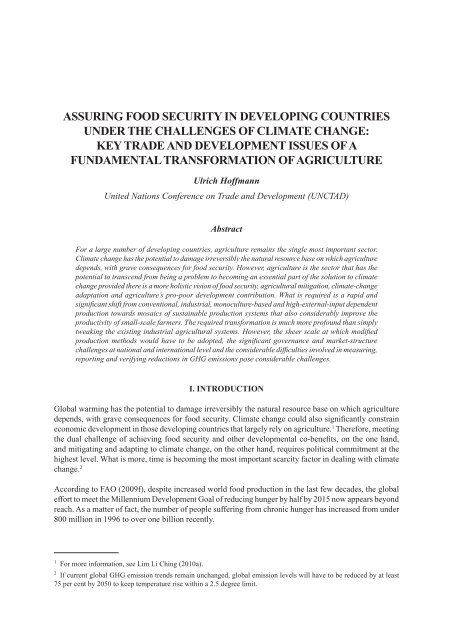Assuring Food Security in Developing Countries under the - Unctad
Assuring Food Security in Developing Countries under the - Unctad
Assuring Food Security in Developing Countries under the - Unctad
You also want an ePaper? Increase the reach of your titles
YUMPU automatically turns print PDFs into web optimized ePapers that Google loves.
<strong>Assur<strong>in</strong>g</strong> <strong>Food</strong> security <strong>in</strong> develop<strong>in</strong>g countries<br />
<strong>under</strong> <strong>the</strong> chAllenges oF climAte chAnge:<br />
Key trAde And development issues oF A<br />
FundAmentAl trAnsFormAtion oF Agriculture<br />
Ulrich Hoffmann<br />
United Nations Conference on Trade and Development (UNCTAD)<br />
Abstract<br />
For a large number of develop<strong>in</strong>g countries, agriculture rema<strong>in</strong>s <strong>the</strong> s<strong>in</strong>gle most important sector.<br />
Climate change has <strong>the</strong> potential to damage irreversibly <strong>the</strong> natural resource base on which agriculture<br />
depends, with grave consequences for food security. However, agriculture is <strong>the</strong> sector that has <strong>the</strong><br />
potential to transcend from be<strong>in</strong>g a problem to becom<strong>in</strong>g an essential part of <strong>the</strong> solution to climate<br />
change provided <strong>the</strong>re is a more holistic vision of food security, agricultural mitigation, climate-change<br />
adaptation and agriculture’s pro-poor development contribution. What is required is a rapid and<br />
significant shift from conventional, <strong>in</strong>dustrial, monoculture-based and high-external-<strong>in</strong>put dependent<br />
production towards mosaics of susta<strong>in</strong>able production systems that also considerably improve <strong>the</strong><br />
productivity of small-scale farmers. The required transformation is much more profound than simply<br />
tweak<strong>in</strong>g <strong>the</strong> exist<strong>in</strong>g <strong>in</strong>dustrial agricultural systems. However, <strong>the</strong> sheer scale at which modified<br />
production methods would have to be adopted, <strong>the</strong> significant governance and market-structure<br />
challenges at national and <strong>in</strong>ternational level and <strong>the</strong> considerable difficulties <strong>in</strong>volved <strong>in</strong> measur<strong>in</strong>g,<br />
report<strong>in</strong>g and verify<strong>in</strong>g reductions <strong>in</strong> GHG emissions pose considerable challenges.<br />
i. <strong>in</strong>troduction<br />
Global warm<strong>in</strong>g has <strong>the</strong> potential to damage irreversibly <strong>the</strong> natural resource base on which agriculture<br />
depends, with grave consequences for food security. Climate change could also significantly constra<strong>in</strong><br />
economic development <strong>in</strong> those develop<strong>in</strong>g countries that largely rely on agriculture. 1 Therefore, meet<strong>in</strong>g<br />
<strong>the</strong> dual challenge of achiev<strong>in</strong>g food security and o<strong>the</strong>r developmental co-benefits, on <strong>the</strong> one hand,<br />
and mitigat<strong>in</strong>g and adapt<strong>in</strong>g to climate change, on <strong>the</strong> o<strong>the</strong>r hand, requires political commitment at <strong>the</strong><br />
highest level. What is more, time is becom<strong>in</strong>g <strong>the</strong> most important scarcity factor <strong>in</strong> deal<strong>in</strong>g with climate<br />
change. 2<br />
Accord<strong>in</strong>g to FAO (2009f), despite <strong>in</strong>creased world food production <strong>in</strong> <strong>the</strong> last few decades, <strong>the</strong> global<br />
effort to meet <strong>the</strong> Millennium Development Goal of reduc<strong>in</strong>g hunger by half by 2015 now appears beyond<br />
reach. As a matter of fact, <strong>the</strong> number of people suffer<strong>in</strong>g from chronic hunger has <strong>in</strong>creased from <strong>under</strong><br />
800 million <strong>in</strong> 1996 to over one billion recently.<br />
1 For more <strong>in</strong>formation, see Lim Li Ch<strong>in</strong>g (2010a).<br />
2 If current global GHG emission trends rema<strong>in</strong> unchanged, global emission levels will have to be reduced by at least<br />
75 per cent by 2050 to keep temperature rise with<strong>in</strong> a 2.5 degree limit.

















